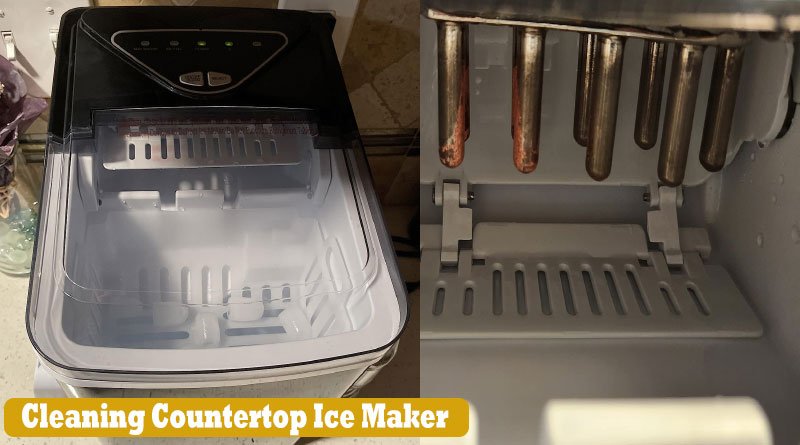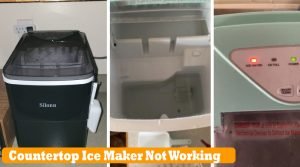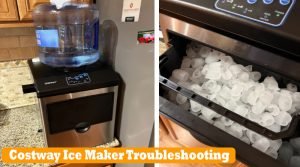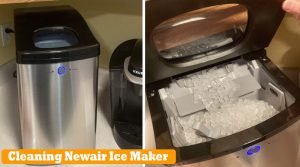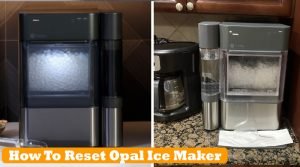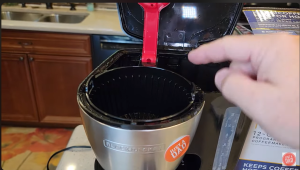Cleaning Countertop Ice Maker: Crystal Clear Secrets
In the pursuit of convenience and modernity, the cleaning countertop ice maker emerges as a practical and efficient solution for those who appreciate the luxury of consistently having ice at their fingertips. This compact marvel not only produces a steady supply of ice for beverages but also addresses the often-overlooked aspect of hygiene by incorporating user-friendly cleaning mechanisms.
In today’s fast-paced world, convenience is vital, and having a compact, efficient ice maker that simplifies the cleaning process can be a game-changer. This introduction will delve into the benefits and features of a cleaning countertop ice maker, offering insights into how it can enhance everyday life while keeping drinks cool and refreshing.
Cleaning Countertop Ice Maker:Essential Tips
A countertop ice maker can be a real hero in your kitchen, delivering a constant stream of ice for your cold drinks or keeping seafood fresh at the perfect temperature. Yet, without regular cleaning, that trusty appliance can become a breeding ground for bacteria and mold.
Let’s dive into the essential steps to keep countertop ice maker clean and your ice pure.
1.Read Manufacturer’s Instructions
Before breaking out the cleaning supplies, read user manual. Manufacturer’s instructions are there for a reason – to ensure you clean ice maker safely and effectively. Every machine may have different parts and mechanisms that require specific care. Remember, safety comes first! Some devices may need you to unplug them before cleaning, while others, like small countertop ice makers, can usually be left running during a cleaning cycle, just as if you were making ice.
Safety Precautions
When it comes to handling anything electrical, simple safety can save lives. Unplug the device if instructed to, or at least turn it off. If you must clean a running machine, take extra care to avoid moving parts or hot surfaces.
2. Regular Cleaning Schedule
Consistency is vital when cleaning any appliance; your countertop ice maker is no exception. The frequency of cleaning sessions largely depends on usage, but a good rule of thumb is deep cleaning ice maker every three to six months. Regular maintenance will not only provide cleaner ice but also extend the life of your appliance.
Benefits of Regular Maintenance
Regular cleanings ensure that your ice maker operates to its full potential, producing taste- and odor-free ice. Over time, mold, mildew, and mineral deposits can build up, affecting the ice’s flavor and quality. Moreover, consistent cleaning can help avoid breakdowns and costly repairs.
3. Cleaning Supplies and Tools
It would help to have a few essential cleaning supplies and tools to maintain ice maker. A mild solution of one part vinegar to ten parts water removes mineral deposits and kills mold and bacteria. You’ll also need a soft cloth for wiping down parts and a small brush for scrubbing those hard-to-reach spaces. Ensure every tool and cleaning supply is cleaned before using it on the ice maker. The last thing you want is to introduce new germs to the environment you’ve just cleaned.
Recommended Cleaning Products
- White vinegar
- Clean, soft cloths
- A soft-bristled brush or toothbrush
- Warm, soapy water
Tools Needed for Effective Cleaning
- Soft cloths or sponges
- Scrub brushes
- Q-tips or cotton swabs for intricate parts
4. Step-by-Step Cleaning Process
Here is a detailed cleaning process to keep countertop ice maker in optimal condition. This guide covers basic cleaning tasks and periodic deep cleaning for more thorough maintenance.
Step 1: Preparing for Cleaning
Begin by preparing your cleaning supplies. You’ll need a soft cloth, a mixture of warm water and mild soap, a sponge, a soft bristle brush, vinegar, or a descaling solution.
Turn off and unplug your ice maker before starting the cleaning process. It is also advisable to allow the machine to thaw by clearing it and opening the ice-dispensing chute. This helps all ice within the maker to melt, making it easier to clean thoroughly.
Step 2: Cleaning the Exterior
Use a damp cloth to clean the exterior of the ice maker. Pay attention to any spills or sticky residue accumulated over time. Abrasive materials should not scratch surfaces. For harder-to-remove stains, a sponge dipped in soapy water can be used. Always remember to dry the surface completely. Once the unit is clean, plug it back in and turn it on to make fresh ice for the next step.
Step 3: Cleaning the Interior Components
Next, focus on the interior. Remove the ice basket and any components in contact with water and ice. Each should be washed with the warm, soapy water mixture and rinsed thoroughly. The evaporator rods might have mineral deposits that must be gently scrubbed with a soft bristle brush to maintain peak performance. Always ensure that every part is arid before reassembly.
Step 4: Descaling and Sanitizing
Descaling is essential if your ice maker has heavy mineral buildup. Use a descaling solution appropriate for ice makers or a natural option like vinegar diluted with water. Allow the solution to sit in the water reservoir for a recommended amount of time, then run a cleaning cycle by dispensing ice into the sink until the solution is removed.
Sanitizing ice maker involves a similar approach. Use a sanitizing solution or a mixture of three parts water to one part vinegar and let it sit for about 5-10 minutes before running ice cycles until flushed out. This step keeps bacteria at bay and ensures a clean ice-making environment.
Step 5: Proper Maintenance Tips
Incorporate these maintenance tips to keep countertop ice maker clean between deep cleans:
- Routinely wipe down the ice maker after use to prevent grime buildup.
- Occasionally, run a batch of ice with a lemon-vinegar solution to keep odors and tastes in check.
- Change filters, if applicable, as the manufacturer recommends, to maintain the water quality used to make ice.
Eco-Friendly Cleaning Options
For those looking to minimize their environmental impact, there are several eco-friendly cleaning alternatives for countertop ice makers.
1. Natural Cleaners
Lemon juice or a solution of lemon juice and water can provide a mild, natural acid that effectively cuts through mineral buildup and reduces odors.
2. Baking Soda
Baking soda is a gentle abrasive used to clean and deodorize the interior. It’s excellent for cleaning as well as removing stains.
3. Water and Vinegar
A solution of one part water to vinegar is a powerful cleaning agent. It’s beneficial for descaling, and it’s biodegradable.
4. Ozone Cleaners
Some eco-friendly options use ozone to sanitize ice makers. These solutions can be a bit more expensive but are incredibly effective and environmentally friendly.
5. Maintenance and Preventive Measures
Even outside of regular cleaning schedule, you can take steps to keep countertop ice maker in top shape. Always use filtered or distilled water for making ice, as tap water can contain impurities that leave residues in machine over time. Additionally, keep an eye on the ice maker’s performance. Any changes in the taste, size, or frequency of ice production could indicate it’s time for an extra cleaning.
Tips to Prevent Buildup and Maintain Optimal Performance
- As mentioned before, using filtered or distilled water can reduce the amount of minerals and additional impurities entering your appliance.
- Staying vigilant: noticing changes in the machine’s production can be a warning sign that something needs cleaning or adjusting.
Check out how to clean Braun coffee maker Start by unplugging the machine from the power source for safety reasons.
Troubleshooting Common Issues of Countertop Ice Maker
If you encounter issues such as machine not producing enough ice, the ice tasting or smelling funny, or the ice being too soft, refer to user manual for specific troubleshooting advice. Often, simple cleaning or adjusting the settings can rectify these problems. If in doubt, contact the manufacturer or a qualified technician for assistance.
Final Thoughts
Cleaning countertop ice maker not only revolutionizes how we access ice but also elevates the standards of cleanliness in our everyday lives. With its compact design, efficiency, and user-friendly cleaning features, this innovative appliance ensures a constant supply of ice while minimizing the effort required for maintenance.
Embrace the future of ice-making convenience and cleanliness by incorporating the cleaning countertop ice maker into home – where functionality meets modernity, and you’ll never have to worry about that refreshing drink being anything less than perfect. Regular maintenance is the key to keeping countertop ice maker working efficiently and producing high-quality ice.
FAQs of Cleaning Countertop Ice Maker
Q: How often should I clean my countertop ice maker?
It’s recommended to clean countertop ice maker at least once every three to six months. However, if you notice any change in the taste or smell of the ice, it may be time for a cleaning.
Q: What can I use to clean my countertop ice maker?
Most manufacturers recommend using a mixture of white vinegar and water or a specialized ice machine cleaner. For specific instructions on cleaning, refer to your user manual.
Q: Can I use bleach to clean my countertop ice maker?
No, bleach can damage the internal parts of your ice maker. Stick to manufacturer-recommended cleaners or vinegar and water.
Q: How do I clean my countertop ice maker?
Generally, you’ll need to empty the ice maker, wipe down the interior with a soft cloth and the recommended cleaning solution, rinse well, and then run a few cycles with clean water.
Q: Why is it important to clean my countertop ice maker?
Regular cleaning prevents the buildup of minerals and other deposits that can affect the taste of your ice and the machine’s performance. It also helps prevent mold and bacteria growth.
Q: Do I need to clean my ice maker if I only use distilled water?
Yes, even with distilled water, mineral deposits can still build up over time, and there’s always a risk of bacteria or mold growth.
Q: Can I put parts of my ice maker in the dishwasher?
This depends on specific model. Some ice makers have dishwasher safe parts, while others do not. Always refer to user manual.
Q: What should I do if my ice smells bad even after cleaning the ice maker?
If your ice still smells after cleaning, there may be a problem with your water source. Try using filtered or bottled water. If the problem persists, contact the manufacturer for support.
Q: What should I do if my ice maker isn’t making ice after cleaning?
Ensure you’ve thoroughly rinsed out any cleaning solution and that all parts are correctly reassembled. If it’s still not working, refer to your user manual or contact the manufacturer.

